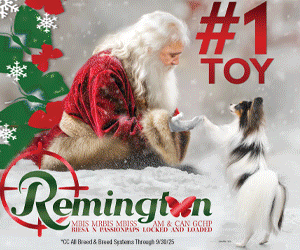“He Got a Good Ribbing”
By Lisa Dube Forman
What exactly is the judge feeling for when examining my dog’s chest? Unfortunately, for many exhibitors brave enough to inquire, they do not receive a thorough nor even sufficient explanation. Thus, the reason remains a mystery to many exhibitors. Well, here I will unveil the mystery.
A truly, well-skilled judge is carefully feeling for the curvature or flatness of the ribcage, from the vertebral column down to the sternum. Ribbing is the narrow, elongated bones emanating from the vertebral column that form the chest wall. The Carnivora, more specifically dog, has thirteen ribs on each side, nine sternal and four asternal which connect with the thirteen thoracic vertebrae of the spinal column. The first nine ribs are called ‘true ribs’, the next three — the tenth, eleventh and twelfth ribs — are called ‘false ribs’, and the last, the thirteenth rib is called the ‘floating rib.’ To uncomplicate this, in lay terms the ‘true ribs’ are attached to the sternum, the ‘false ribs’ are hinged into the bottom of the ninth rib and therefore not directly connected with the sternum, and the floating rib — the shortest rib — is not connected to the sternum below. Hence the term ‘floating.’
The shape or contours of these ribs can vary in the many different breeds. To illustrate, well rounded ribs, also known as barrel-shaped, are well-arched from the top attachment of the thoracic vertebrae (outwards) to the bottom. An example of this would be the Bulldog which calls for well-rounded and very deep ribs, and is often called for in the stocky ‘Bully’ breeds. The Mastiff also necessitates ribs that are well-rounded with the ‘false ribs’ deep and well set back. A contrasting shape is ribbing that is smooth and not well sprung, such as the Ibizan Hound, that requires ribs only slightly sprung.
The most common rib formation is the egg-shaped or oval shaped chest which is typical for the majority of breeds. To illustrate, the Briard demands an egg-shaped form, with moderately curved ribs and is not too rounded like the previous working breeds. A formation rarely requested are flat ribs that require less curvature. At the cross section they lay flat and are not rounded or bowed while radiating downwards. This is illustrated by the Bearded Collie whose ribs, though well sprung from the spine but are flat at the sides or cross sections. This is also true of the Bedlington, who has a deep chest but is indeed flat as the ribs approach the sternum. I should mention a singular defect in ribbing described in the Basset Hound standard called ‘flanged ribs.’ This is a condition in which the ribs are deformed at the bottom, creating a ridge or rim sticking out and is thought to be common with flatsideness. Both of which are faults on a Bassett.
Flat ribs are not always slab-sided which is the state of being narrow throughout. The slab-sided rib has very little to no arch, roundness or spring from the spinal column. It is flat throughout beginning at the articulation from the vertebras continuing downwards. Slab-sidedness and flat ribs are atypical for almost all breeds but especially is a serious fault, or antithesis for the endurance hunting dogs such as Beagles, Foxhounds and Wolfhounds.
The reason is that rib curvature determines the shape of the chest and influences chest capacity that in turn governs maximum lung and heart development. The flatter the spring or arch of the ribs, the less development of the heart and lungs and tolerance to exercise.
There are other key factors to understand proper ribbing besides shape discussed above. All though are essential to one another and are extremely important. Width often describes chest breadth, as seen in the American Staffordshire Terrier whose blueprint calls for a deep, broad chest. When one looks at the dog from the front, you can observe the well-rounded shape and great breadth of chest. This is the opposite of what you’d find on the Borzoi who has a rather narrow breadth of chest, although very deep brisket. This leads me to the next key, depth. Depth of ribs and chest is generally desired to the point of elbow, with the opposite being shallow if the chest does reach the point of elbow.
The last key factor is length of rib cage. This is frequently described as well-ribbed back, ribbed-up well, well ribbed up, or long ribbed back. All of which describe ribs that are carried well back on the trunk, especially correlating to the length of loin or coupling. Length of ribbing is crucial for the hunting breeds as it relates to chest capacity already discussed. In short, it is vital for superior stamina.
‘Well-developed’ is the compilation of all three key factors including the rib or chest shape. The opposite is described as shelly or shell-like that refers to at shallow, narrow body, and inadequate chest measurements, where the Rottweiler and Standard Schnauzer standards mention such as faulty.
Summing up, the chest and ribbing is vital in many aspects as it contains and is armor for the vital internal organs, i.e. heart, lungs. It is crucially linked to the development of such organs and in turn, is inextricably linked to endurance and performance. Although we use the expression in jest about ourselves, ‘he got a good ribbing’ in dogs is of major importance.
Short URL: http://caninechronicle.com/?p=37508
Comments are closed











